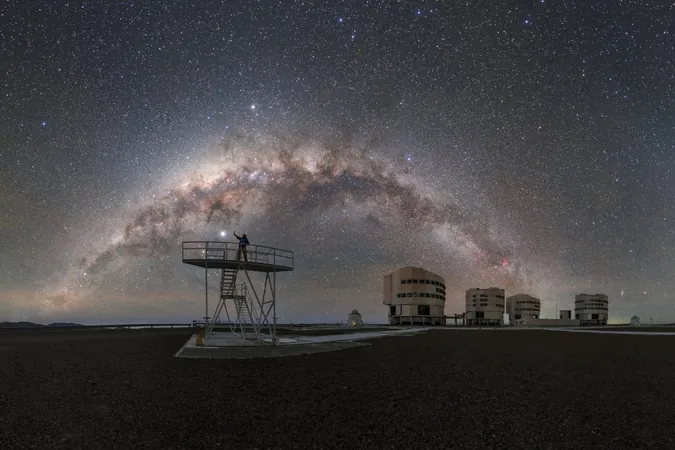
Industrial Complex Proposal Poses Major Threat to Astronomy's Clearest Skies
2025-01-09
Author: Nur
Industrial Complex Proposal Poses Major Threat to Astronomy's Clearest Skies
The European Southern Observatory (ESO) is sounding alarm bells as its flagship Paranal Observatory in Chile's Atacama Desert stands on the brink of losing its unparalleled clear skies due to a proposed industrial complex. This complex, spearheaded by a subsidiary of the U.S. power company AES Andes, threatens to jeopardize some of the world's most vital astronomical research.
A Glimpse of the Universe Compromised
Home to the Very Large Telescope (VLT), the Paranal Observatory is renowned for its precision and clarity. The VLT comprises four massive telescopes, each equipped with a 27-foot (8.2-meter) mirror, and four auxiliary telescopes that boast 6-foot (1.8-meter) mirrors. Collectively, they offer breathtaking views of the cosmos, unraveling mysteries both near and far. However, the planned industrial project, named Inna, could negatively impact these capabilities by increasing light pollution and atmospheric turbulence over this precious astronomical site.
The Scale of the Threat
The Inna project envisions an expansive industrial-scale green hydrogen facility, covering over 7,413 acres and featuring a port, ammonia, and hydrogen production plants, as well as thousands of electric generators. Alarmingly, this site is proposed to be situated just 3 to 7 miles (5 to 11 kilometers) from the observatory, directly threatening the very environment that allows astronomers to peer deeper into space.
“The environmental consequences are of primary concern,” stated Itziar de Gregorio, ESO’s Representative in Chile. “Chile's Atacama Desert is an irreplaceable asset for global astronomy, providing some of the darkest skies on Earth. It is paramount that we consider alternative sites for this significant industrial development.”
A Legacy of Discovery
The VLT has made remarkable contributions to our understanding of the universe, with recent achievements including the capture of new images of the solar system’s largest asteroids in 2021, as well as seeing the results of NASA’s DART mission in 2023. With ongoing construction of the Giant Magellan Telescope and the launch of the LSST Camera at the Rubin Observatory, 2023 is a pivotal year for astronomical advancements.
Illustrating the global importance of dark skies for astronomy, a study in 2022 revealed that Paranal experienced significantly less light pollution than 27 other major observatories. However, even slight increases in light pollution can severely impair observations, exacerbating challenges already posed by increasing satellite constellations cluttering Earth's orbit.
The Inevitable Consequences of Light Pollution
Research indicates the night sky is growing 9.6% brighter each year globally, leading to the vanishing of dimmer stars for many stargazers. The implications for biodiversity are equally alarming, with light pollution disrupting circadian rhythms and affecting ecosystems on a broader scale.
The ESO emphasizes, “We must preserve Paranal's unique skies, which are crucial for future astronomical breakthroughs and our understanding of the universe.” With the Extremely Large Telescope set to launch near Paranal in 2028, the stakes could not be higher.
A Call to Action
Astrophysicists are urging immediate and collective action to mitigate light pollution, as it's not merely an inconvenience but a looming catastrophe for future generations of astronomers. The ESO has proposed relocating the AES Andes project as a necessary measure to protect the integrity of the night skies essential for astronomical research.
As Chilean authorities weigh the environmental impacts of this ambitious green energy project, the balance between renewable energy development and the preservation of invaluable astronomical assets hangs in the balance. Will we safeguard the cosmos for future explorations, or pave the way for industrial shadows to dim our understanding of the universe? The answer could determine the fate of astronomy itself.


 Brasil (PT)
Brasil (PT)
 Canada (EN)
Canada (EN)
 Chile (ES)
Chile (ES)
 Česko (CS)
Česko (CS)
 대한민국 (KO)
대한민국 (KO)
 España (ES)
España (ES)
 France (FR)
France (FR)
 Hong Kong (EN)
Hong Kong (EN)
 Italia (IT)
Italia (IT)
 日本 (JA)
日本 (JA)
 Magyarország (HU)
Magyarország (HU)
 Norge (NO)
Norge (NO)
 Polska (PL)
Polska (PL)
 Schweiz (DE)
Schweiz (DE)
 Singapore (EN)
Singapore (EN)
 Sverige (SV)
Sverige (SV)
 Suomi (FI)
Suomi (FI)
 Türkiye (TR)
Türkiye (TR)
 الإمارات العربية المتحدة (AR)
الإمارات العربية المتحدة (AR)